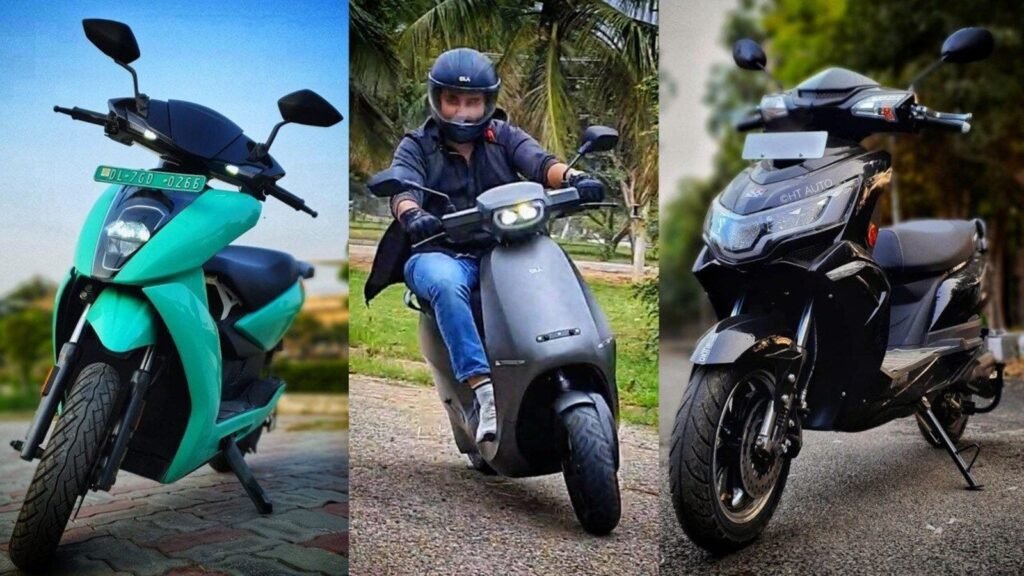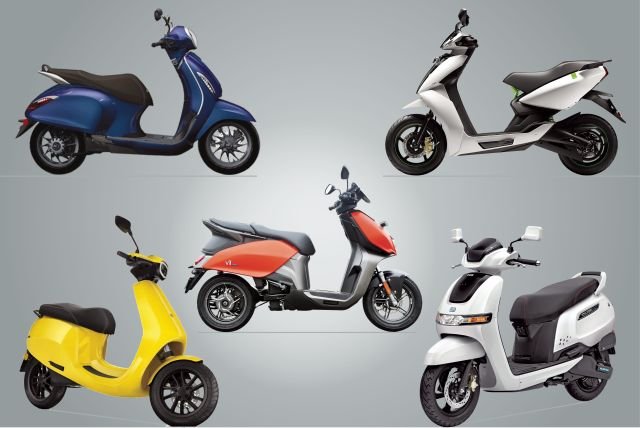Range fear is a problem that EV scooters all too often face. When you have to make long trips in rush hour traffic every day, park in spots where charging is not an option, and rely on the remaining battery power to get home, you are bound to run into problems. Thus, there’s no better method to tackle the problem than to arrange four top-drawer scooters from the top four manufacturers in the industry.

Comparison of EV scooters
Two of the most well-known Indian EV start-ups produce the Ather 450X and Ola S1 Pro e-scooters. Their e-scooter’s performance-focused design is visible in the size of its electric motors and batteries. With 58Nm of power, the Ola S1 Pro is the most potent e-scooter available. It goes without saying that, by far, it is the fastest to reach 60 mph and even 80 mph. Its maximum speed, validated by Vbox at 99.8 kph, is far faster than the Ather’s greatest speed of 80 kph according to GPS.
The Ola’s stated maximum speed is 115 kph, while the Ather’s is 90 kph. Even when the battery percentage drops below 10%, the Ather 450X’s Eco mode is still fairly useful. Even at speeds of up to 40 km/h, the scooter can also climb flyovers at such a low battery level.
When you put the Ather in “Ride” mode, you’ll discover that it has sufficient performance for everyday commuting. Clearly, “Sport” and “Warp” are for riders who are prepared to forgo battery life in exchange for speed, and our testing indicates that the Ather is the second-fastest scooter in this comparison.
More significantly, you can ride the 450X in “Warp” mode for as long as the battery’s state of charge (SoC) is higher than 20% because to its excellent heat management. Out of all of them, it also boasts the best accelerator reaction and feedback.
The enormous 36-liter boot space of the S1 Pro is a clear indication of the advantages of placing the batteries in the floor. There is more than enough space for your laptop, workplace supplies, or groceries, even with the charger inside. Two half-face helmets can also fit within the boot, albeit they won’t have the charger.
With a capacity of 22 litres, the Ather 450X boasts the second largest boot, making it ideal for carrying daily necessities. Nonetheless, the volume of cargo that can be carried inside is restricted by the portable charger. Comparably, the 17-liter trunk of the iQube which includes a sizable portable charger is just big enough to transport a few things. Out of the four scooters, the Ather 450X has the finest handling characteristics.
The rider is given confidence by the Gen 3 avatar’s small weight, short wheelbase, communicative chassis, and larger, more grippy tyres. The Ather is a lot of fun, whether you’re blasting around a corner or weaving through traffic. In contrast, the Ola S1 Pro’s single-sided telescopic front and monoshock suspension system provide for a significantly smoother ride. It keeps the scooter rooted through sweeping turns and handles uneven roads fairly well. Its wider tyres here also help with handling to some extent.
The ride and handling characteristics of the TVS iQube are nicely balanced. The preload-adjustable dual shocks in the back are more aggressively set up than the telescopic fork on this bike. The scooter’s front end absorbs a lot of bumps and potholes, but it also bottoms out far too readily over larger ones.
Handling-wise, it’s very predictable, especially after you get used to the feeling of having an electric motor on the back wheel. It goes without saying that a larger battery will have a longer range. Because it can travel the furthest on a single charge, the Ola S1 Pro has a distinct advantage over the others.
It goes without saying that a larger battery will have a longer range. Because it can travel the furthest on a single charge, the Ola S1 Pro has a distinct advantage over the others. It ran for 130km in Eco mode and 127km in Normal mode. That’s significantly less than the Eco mode’s stated range, and we figure that’s because we had to drive the entire time with the accelerator wide open to compensate for the poor performance and safely keep up with traffic.
The Bajaj Chetak’s battery died after travelling 104.5 km in Eco, however the TVS iQube travels 107.2 km in Eco and 96 km in Power. It is important to remember that as SoC falls below 5 percent, each scooter’s performance and top speed drastically decrease. The Bajaj prevents you from riding in Sport mode below 30 percent SoC, while the Chetak and Ola lose performance sooner than the others as the battery drains. When the battery level drops, the Ola also indicates a shorter range than you might anticipate.
The S1 Pro boasts a rather sharp touchscreen display that offers a tonne of information and controls for different features. It’s also the only scooter in this group that can only be unlocked and activated using a passcode rather than a key. If you want to travel long distances on the highway, the cruise control option is really helpful, but the on-board audio speakers are a feature that’s exclusive to this market.
The other scooter with a touchscreen here is the Ather 450X, and we thought it was the most user-friendly. Although responsiveness has improved with a 2GB RAM upgrade, the built-in Google Maps still takes a while to load. The iQube app allows users to receive calls, SMS alerts, Instagram updates, manage music playing on a headset, and much more. The iQube S’s redesigned display is sharper and larger than its predecessor.
The screen’s colour and graphics changing when you roll off the throttle and the motor enters regen irritated us. This may be very unsettling, especially at night, since it causes the screen to flicker continuously when you are in heavy traffic and stepping on and off the accelerator. The display can be made to function better by manually switching it to night mode. Finally, the LCD display on the Chetak appears to be the most simplistic. It is challenging to read in broad daylight and contains a lot of information.


